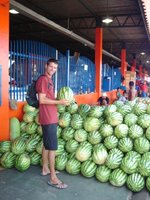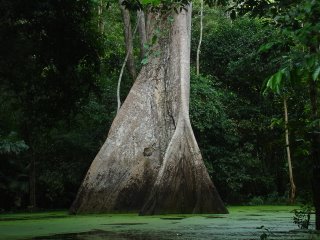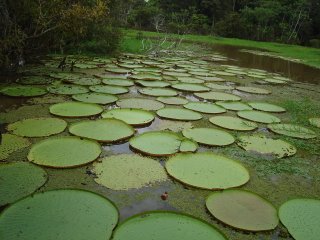 Manaus grew during the mid to late 19th century as part of the rubber boom. Colonial architecture is scattered throughout the city and this includes the famous Opera House. There are several buildings that were manufactured in Europe and then shipped to Brazil and assembled.
Manaus grew during the mid to late 19th century as part of the rubber boom. Colonial architecture is scattered throughout the city and this includes the famous Opera House. There are several buildings that were manufactured in Europe and then shipped to Brazil and assembled.The morning of our first day we began the business of sorting out jungle tours and onward boats. After talking with several tour operators about potential options for jungle excursions we made our way down to the floating port
 on the Rio Negro. The main port of Manaus was designed to be floating because the water level of the Rio Negro varies as much as 15m (50 ft) over the course of the year. It is a continuously busy place with a constant stream of people and products.
on the Rio Negro. The main port of Manaus was designed to be floating because the water level of the Rio Negro varies as much as 15m (50 ft) over the course of the year. It is a continuously busy place with a constant stream of people and products.After looking at the timetables for boats upriver we realized that we would only be able to spend one more day in Manaus, and would have to leave by boat on Friday the 28th of April. We booked passage on the Alm Te Monteiro, a medium sized passenger and cargo ship.
 Having taken care of the most important task we needed to in Manaus we began to explore the waterfront area of the city. We meandered our way through the central market, which had a few arts and crafts, and the distribution market which is the hub for all of the food products that are used by everyday people. It has piles of any type of produce you can think of as well as several types of fruits that you have never seen before. The market also contains the typical section of animal parts splayed out on tile counters.
Having taken care of the most important task we needed to in Manaus we began to explore the waterfront area of the city. We meandered our way through the central market, which had a few arts and crafts, and the distribution market which is the hub for all of the food products that are used by everyday people. It has piles of any type of produce you can think of as well as several types of fruits that you have never seen before. The market also contains the typical section of animal parts splayed out on tile counters.The waterfront district of Manaus is a giant commercial center with almost every street front of building and sidewalk space taken up by commercial shops and stalls and stands. Manaus is the hub for the entire Amazon basin and it is very common for people to come to the city from smaller towns to stock up on everything they need for the next several months. This principally consists of household items, clothes, and the like. Manaus also serves as Brazil center for appliance manufacture and so things like TVs and DVD players are very cheap so lots of Brazilians fly to Manaus to buy them.
Along the way we made preparations for our journey up the river. This included purchasing cookies, powdered drink mix, hot chocolate powder, toilet paper, fruit, bread rolls, packets of tuna fish, water, and various vegetables. We also bought hammocks, which we would be sleeping in for the next week.

That afternoon we booked a tour for the next day to go to the Meeting of the Waters and the Parque Ecologico Janauary. The Meeting of the Waters is where the Rio Solimoes and the Rio Negro come together. Because the two rivers are different temperatures, moving at different speeds, and have different nutrient contents they take more than 20 km to start mixing. As a result there is a very distinct line between the two.
Here are a few photos from the ecological park.







No comments:
Post a Comment